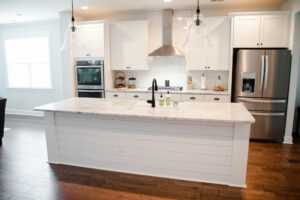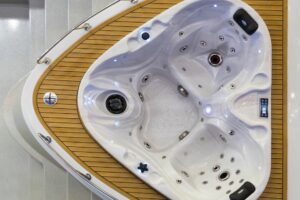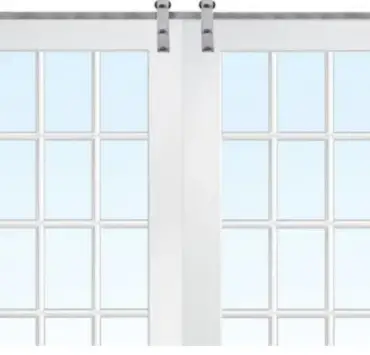Here are the steps to follow when hanging a frameless mirror:
Step 1: Gather your materials
Before you begin, ensure you have all the necessary materials. You’ll need a measuring tape, a pencil, a level, a stud finder, mirror clips or adhesive, and a drill or screwdriver. Make sure the screws or anchors you use are appropriate for the weight of your mirror and the type of wall you’re hanging it on.
Step 2: Measure the space
Measure the space where you want to hang your mirror, taking into account any furniture or other items in the room. Mark the center of the area with a pencil, and use a level to ensure that the line is straight.
Step 3: Find the studs
Studs provide the best support for heavy mirrors, so hang your mirror on a stud if possible. Use a stud finder to locate the studs in the wall where you want to hang your mirror. If there are no studs where you want to hang your mirror, you’ll need to use wall anchors to provide additional support.
Step 4: Mark the mounting points
Once you’ve located the studs (or determine where you’ll use wall anchors), use a pencil to mark the mounting points on the wall. You’ll want to use at least two mounting points, with one on each side of the mirror. Measure the distance between the mounting points and ensure it’s equal to the distance between the clips or adhesive on the back of your mirror.
Step 5: Install the mounting hardware
If you use mirror clips, attach them to the wall at the mounting points using screws or wall anchors. Make sure they’re level and secure. If you’re using adhesive, follow the manufacturer’s instructions to apply it to the back of the mirror and attach it to the wall. Press firmly and hold the mirror in place for the recommended time.
Step 6: Hang the mirror
Once the mounting hardware is in place, carefully hang the mirror on the clips or adhesive. Make sure it’s level and adjust as necessary. If you’re using mirror clips, you may need to tighten them to ensure the mirror is secure.
Step 7: Enjoy your new mirror!
With your mirror securely in place, step back and admire your handiwork. A frameless mirror can add a lot to a room, reflecting light and creating the illusion of more space. Take care when cleaning your mirror to avoid damaging the edges, and enjoy the beauty and functionality it brings to your home.
In conclusion, hanging a frameless mirror doesn’t have to be a daunting task. Follow these simple steps to create a beautiful and functional addition to your home décor. With the right tools, a little planning, and some patience, you’ll have a mirror that will reflect your style and brighten up your space for years to come.
Most Asked Questions
What do you use to hang a frameless mirror?
You can use mirror clips, adhesives, or specialized brackets designed to hang a frameless mirror. Mirror clips are typically metal and attach to the wall with screws or wall anchors. They hold the mirror in place with pressure and do not require any additional support. The adhesive is another option for hanging a frameless mirror. It’s essential to use an adhesive specifically designed for mirrors and follow the manufacturer’s instructions carefully. Specialized brackets for frameless mirrors are also available and can be attached to the wall with screws or wall anchors, and then the mirror is hung on the brackets.
How do you stick a frameless mirror to the wall?
You can use adhesive designed for mirrors to stick a frameless mirror to the wall. Make sure to choose an adhesive that’s appropriate for the weight of your mirror and follow the manufacturer’s instructions carefully. Some adhesives require a certain amount of time to cure before hanging the mirror, so plan accordingly. It’s also important to ensure the wall’s surface is clean and dry before applying the adhesive.
How do you hang a framed mirror on the wall?
You’ll need to use picture or D-ring hangers to hang a framed mirror on the wall. These hangers attach to the back of the mirror with screws or nails and then hang on a nail or screw that’s been inserted into the wall. It’s necessary to use a level to ensure the mirror is straight before securing the hangers to the back of the mirror.
How do you hang a frameless mirror with brackets?
Attach the brackets to the wall using screws or wall anchors. Make sure to choose brackets that are appropriate for the weight of your mirror. Then, attach the mirror to the brackets using screws or clips that are designed for the specific type of brackets you’re using. Using a level to ensure the mirror is straight before attaching it to the brackets is important.
Can you hang a frameless mirror with command strips?
While hanging a small frameless mirror with command strips is possible, it’s generally not recommended for larger or heavier mirrors. Command strips are adhesive strips that are designed to hold lightweight objects. The weight capacity of command strips varies depending on the size and type of strip, so it’s essential to check the packaging and follow the instructions carefully.
How do you hang a frameless mirror without studs?
You’ll need to use wall anchors or specialized adhesive designed for mirrors to hang a frameless mirror without studs. Wall anchors are small devices that expand behind the drywall to provide additional support. Make sure to choose anchors that are appropriate for the weight of your mirror and follow the manufacturer’s instructions carefully. Specialized adhesive designed for mirrors can also be used, but it’s important to choose an adhesive that’s appropriate for the weight of your mirror and to follow the manufacturer’s instructions carefully.
What is the best glue to hang a frameless mirror?
The best glue to hang a frameless mirror will depend on the weight of the mirror and the type of wall you’re hanging it on. Choose an adhesive specifically designed for mirrors and follow the manufacturer’s instructions carefully. Some popular options include Liquid Nails Mirror Adhesive, Gorilla Heavy Duty Construction Adhesive, and E6000 Craft Adhesive.
How much weight can you hang on drywall?
It’s generally recommended to stay within 50 pounds on a single anchor in drywall. If you’re hanging something heavier than 50 pounds, it’s important to use multiple anchors or find a stud to anchor to. Several types of anchors can be used in drywall, including toggle bolts, molly bolts, and plastic anchors. Make sure to choose an anchor appropriate for the weight of the object you’re hanging and follow the manufacturer’s instructions carefully.
How do you hang something heavy on the wall without a stud?
You’ll need to use wall anchors or a toggle bolt to hang something heavy on the wall without a stud. Wall anchors are small devices that expand behind the drywall to provide additional support. Make sure to choose anchors appropriate for the weight of the object you’re hanging and follow the manufacturer’s instructions carefully. A toggle bolt is another option for hanging heavy objects. It consists of a screw that’s threaded through a metal bar, which is then inserted through a hole in the wall. Once inside the wall, the metal bar expands to provide additional support. Choosing a toggle bolt appropriate for the weight of the object you’re hanging is crucial. Always follow the manufacturer’s instructions carefully. Using a level to ensure that the object is hanging straight before securing it to the wall is also a good idea.








